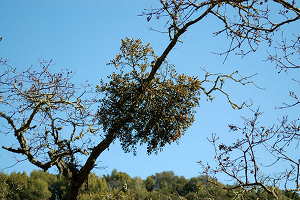 Mistletoe grows on the branch of an oak tree in Briones Regional Park. Photo: kqedquest.
Mistletoe grows on the branch of an oak tree in Briones Regional Park. Photo: kqedquest.
Have you been hanging out under the mistletoe at holiday parties, hoping for a kiss? Well, that mistletoe is more than a Christmas kissing custom. It’s a parasite that can harm trees—and a potential treatment for cancer.
Mistletoe lives on the branches of trees, and is a hemi-parasite; it produces some of its own food (it has green, photosynthetic leaves), but it gets nutrients and water from its host plant (its roots tap into the host plant, rather than the soil). If the mistletoe grows big enough, they can do some damage. Large mistletoe plants can weigh down tree branches and make them more likely to break off during a storm. If there are many mistletoe plants in a single tree, they can stunt the tree’s growth, make it more susceptible to disease, and even kill it.
There are several species of mistletoe living in California. Pacific mistletoe, Phoradendron villosum, lives in the western US, and is a parasite on oak trees. European mistletoe, Viscum album, parasitizes a wide range of species, including apple trees and maples.
